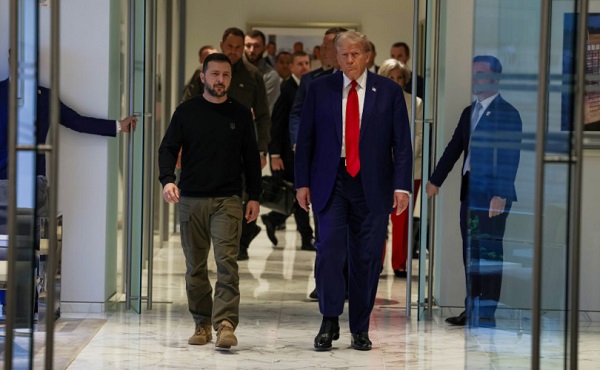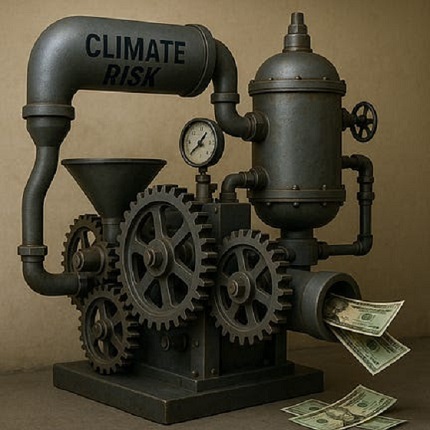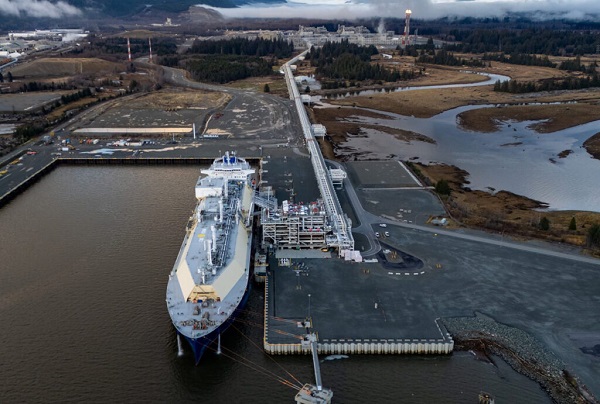Business
Scott Bessent says U.S., Ukraine “ready to sign” rare earths deal

 MxM News
MxM News
Quick Hit:
During Wednesday’s Cabinet meeting, Treasury Secretary Scott Bessent said the U.S. is prepared to move forward with a minerals agreement with Ukraine. President Trump has framed the deal as a way to recover U.S. aid and establish an American presence to deter Russian threats.
Key Details:
-
Bessent confirmed during a Cabinet meeting that the U.S. is “ready to sign this afternoon,” even as Ukrainian officials introduced last-minute changes to the agreement. “We’re sure that they will reconsider that,” he added during the Cabinet discussion.
-
Ukrainian Economy Minister Yulia Svyrydenko was reportedly in Washington on Wednesday to iron out remaining details with American officials.
-
The deal is expected to outline a rare earth mineral partnership between Washington and Kyiv, with Ukrainian Armed Forces Lt. Denis Yaroslavsky calling it a potential turning point: “The minerals deal is the first step. Ukraine should sign it on an equal basis. Russia is afraid of this deal.”
Diving Deeper:
The United States is poised to sign a long-anticipated rare earth minerals agreement with Ukraine, Treasury Secretary Scott Bessent announced during a Cabinet meeting on Wednesday. According to Bessent, Ukrainians introduced “last minute changes” late Tuesday night, complicating the final phase of negotiations. Still, he emphasized the U.S. remains prepared to move forward: “We’re sure that they will reconsider that, and we are ready to sign this afternoon.”
As first reported by Ukrainian media and confirmed by multiple Ukrainian officials, Economy Minister Yulia Svyrydenko is in Washington this week for the final stages of negotiations. “We are finalizing the last details with our American colleagues,” Ukrainian Prime Minister Denys Shmyhal told Telemarathon.
The deal follows months of complex talks that nearly collapsed earlier this year. In February, President Trump dispatched top officials, including Bessent, to meet with President Volodymyr Zelensky in Ukraine to hammer out terms. According to officials familiar with the matter, Trump grew frustrated when Kyiv initially refused U.S. conditions. Still, the two sides ultimately reached what Bessent described as an “improved” version of the deal by late February.
The effort nearly fell apart again during Zelensky’s February 28th visit to the White House, where a heated Oval Office exchange between the Ukrainian president, Trump, and Vice President JD Vance led to Zelensky being removed from the building and the deal left unsigned.
Despite those setbacks, the deal appears to be back on track. While no public text of the agreement has been released, the framework is expected to center on U.S.-Ukraine cooperation in extracting rare earth minerals—resources vital to modern manufacturing, electronics, and defense technologies.
President Trump has publicly defended the arrangement as a strategic and financial win for the United States. “We want something for our efforts beyond what you would think would be acceptable, and we said, ‘rare earth, they’re very good,’” he said during the Cabinet meeting. “It’s also good for them, because you’ll have an American presence at the site and the American presence will keep a lot of bad actors out of the country—or certainly out of the area where we’re doing the digging.”
Trump has emphasized that the deal would serve as a form of “security guarantee” for Ukraine, providing a stabilizing American footprint amid ongoing Russian aggression. He framed it as a tangible return on the billions in U.S. aid sent to Kyiv since the start of Russia’s 2022 invasion.
Local Business
Red Deer Downtown Business Association to Wind Down Operations

The Downtown Business Association (DBA) Board of Directors has made the decision to wind down the Association’s operations at the end of 2025.
The Board determined that the Association is no longer able to operate sustainably under the financial framework available for 2026. After exploring all reasonable alternatives, the Board concluded that it could not continue without reducing services to a level that would no longer provide meaningful value to levy-paying businesses.
The DBA does not receive any operating funding from City Hall in a regular year, all funds raised are through Business Improvement Area Levy that consists of a mandatory levy placed on all businesses operating within the Business Improvement Area. These funds are legislated under the Municipal
Government Act, to be used to promote the Business Improvement Area, which is achieved through marketing and event initiatives along with providing advocacy support primarily to local government on behalf of the business community.
In recent years, the DBA has been a committed advocate for re-examining the approach to Downtown Governance. The Board has consistently maintained that the responsibility for funding downtown initiatives in such a socially charged environment should not rest solely with the business community.
Despite their efforts, the DBA recognized that the funds generated through the Business Improvement Area Levy were insufficient to effectively address the growing challenges of the current operating environment. This ongoing financial strain highlighted the need for a more equitable and sustainable
model to re-establish the downtown as a safe and welcoming heart of the city.
At the annual DBA budget presentation to City Hall, the DBA requested the essential funding needed to implement the Greater Downtown Governance Committee’s recommendations — work that the DBA is uniquely positioned to lead and has been delivering despite depleting resources for many years. The request was not approved. Instead, The City offered a one-time $100,000 Grant-in-Lieu, paired with a proposed 60% increase to the Business Improvement Area levy in 2026.
After careful analysis, the Board concluded that increasing the levy would place undue strain on already challenged businesses and compromise the DBA’s role as a trusted advocate. Operating with the reduced funding of $225,000 would require further staff reductions in an already under resourced environment and a significant reduction in programs, making it impossible to deliver the level of support that downtown businesses deserve and vitally need.
Beginning January 1, 2026, the City of Red Deer will become the primary contact point for matters previously supported by the DBA, including downtown support programs, business-district coordination, events, safety and cleanliness support, and stakeholder engagement. The DBA will work with City staff to support a smooth transition.
The DBA will continue to provide Clean Team services through the delivery of the City-funded environmental contract until February 1st, 2026.
Quote from CEO, Amanda Gould:
“To our business community, we have always operated with your best interests in our heart, continually driving the vision of a thriving downtown environment that serves every member of our community. The changes ahead will have a significant impact on downtown, as there will no longer be an organization dedicated to ensuring the downtown remains top-of-mind, leading events, marketing initiatives, or advocating on your behalf. It is likely you will experience less coordinated support and collective representation.
After 13 years of service to you and our beautiful downtown, it is with great personal sadness that we find ourselves here, but our message remains clear – addressing the unique challenges of our downtown should not rest solely on your shoulders. We cannot, in good faith, collect a levy that does not enable us to provide the essential services needed for our evolving downtown landscape”.
Quote from DBA Board Chair, Brandon Bouchard:
“The incredible staff at the Downtown Business Association have consistently delivered on their mandate with outstanding dedication and effectiveness. Through their efforts, they have successfully promoted the downtown area, organized impactful marketing and event initiatives, and provided steadfast
advocacy support for the business community. Their work has extended well beyond the legislated requirements, as they have proactively responded to the evolving needs of downtown businesses, adapting to challenges and supporting operations within a complex and changing environment.
Despite the staff’s relentless commitment to positioning the DBA as an effective leader for downtown interests, the absence of a sustainable funding model has made it impossible to continue delivering meaningful support. The Board cannot, in good conscience, propose a levy that does not enable the
Association to meet the required level of service, address the shifting priorities of the business community, or respond to the continually evolving needs of the downtown”.
Agriculture
Growing Alberta’s fresh food future

A new program funded by the Sustainable Canadian Agricultural Partnership will accelerate expansion in Alberta greenhouses and vertical farms.
Albertans want to keep their hard-earned money in the province and support producers by choosing locally grown, high-quality produce. The new three-year, $10-milllion Growing Greenhouses program aims to stimulate industry growth and provide fresh fruit and vegetables to Albertans throughout the year.
“Everything our ministry does is about ensuring Albertans have secure access to safe, high-quality food. We are continually working to build resilience and sustainability into our food production systems, increase opportunities for producers and processors, create jobs and feed Albertans. This new program will fund technologies that increase food production and improve energy efficiency.”
“Through this investment, we’re supporting Alberta’s growers and ensuring Canadians have access to fresh, locally-grown fruits and vegetables on grocery shelves year-round. This program strengthens local communities, drives innovation, and creates new opportunities for agricultural entrepreneurs, reinforcing Canada’s food system and economy.”
The Growing Greenhouses program supports the controlled environment agriculture sector with new construction or expansion improvements to existing greenhouses and vertical farms that produce food at a commercial scale. It also aligns with Alberta’s Buy Local initiative launched this year as consumers will be able to purchase more local produce all year-round.
The program was created in alignment with the needs identified by the greenhouse sector, with a goal to reduce seasonal import reliance entering fall, which increases fruit and vegetable prices.
“This program is a game-changer for Alberta’s greenhouse sector. By investing in expansion and innovation, we can grow more fresh produce year-round, reduce reliance on imports, and strengthen food security for Albertans. Our growers are ready to meet the demand with sustainable, locally grown vegetables and fruits, and this support ensures we can do so while creating new jobs and opportunities in communities across the province. We are very grateful to the Governments of Canada and Alberta for this investment in our sector and for working collaboratively with us.”
Sustainable Canadian Agricultural Partnership (Sustainable CAP)
Sustainable CAP is a five-year, $3.5-billion investment by federal, provincial and territorial governments to strengthen competitiveness, innovation and resiliency in Canada’s agriculture, agri-food and agri-based products sector. This includes $1 billion in federal programs and activities and $2.5 billion that is cost-shared 60 per cent federally and 40 per cent provincially/territorially for programs that are designed and delivered by provinces and territories.
Quick facts
- Alberta’s greenhouse sector ranks fourth in Canada:
- 195 greenhouses produce $145 million in produce and 60 per cent of them operate year-round.
- Greenhouse food production is growing by 6.2 per cent annually.
- Alberta imports $349 million in fresh produce annually.
- The program supports sector growth by investing in renewable and efficient energy systems, advanced lighting systems, energy-saving construction, and automation and robotics systems.
Related information
-

 Business1 day ago
Business1 day agoCanada Can Finally Profit From LNG If Ottawa Stops Dragging Its Feet
-

 Health2 days ago
Health2 days agoThe Data That Doesn’t Exist
-

 Business2 days ago
Business2 days agoThe Climate-Risk Industrial Complex and the Manufactured Insurance Crisis
-

 Crime2 days ago
Crime2 days agoInside the Fortified Sinaloa-Linked Compound Canada Still Can’t Seize After 12 Years of Legal War
-

 Automotive12 hours ago
Automotive12 hours agoThe $50 Billion Question: EVs Never Delivered What Ottawa Promised
-

 National2 days ago
National2 days agoLiberal bill “targets Christians” by removing religious exemption in hate-speech law
-

 Health1 day ago
Health1 day agoUS podcaster Glenn Beck extends a lifeline to a Saskatchewan woman waiting for MAiD
-

 Energy2 days ago
Energy2 days agoLNG NOW! Canada must act fast to prosper in changing times






